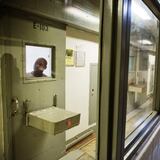When Susan Booth dreamed of a new theater, she envisioned the earthy tones of unpainted wood and the encircling arms of a warm embrace.
The image she associated with that dream was one of those exquisite bowls carved by wood-turner Ed Moulthrop.
“They look like what a hug would feel like if you rendered one in natural materials,” said Booth, artistic director of the Alliance Theatre.
That was more than three years ago.
Last year construction crews tore the insides of the old Alliance down to the dirt. In that shell they built a new structure, adding two new floors, new audio and lighting gear and the sort of production facilities that make blockbuster, Broadway-bound musicals roll out on rails.
Most of the $32 million renovation will be hidden from audiences. What patrons will see Jan. 16, when the curtain goes up on the big-budget Cinderella musical, “Ever After,” should make Booth happy.
Patrons will be 10 to 15 feet closer to the stage than in the old hall. They will sit in an orchestra that wraps around the proscenium, in a balcony that’s lower, in box seats that are open to foot traffic, in a theater that is, to choose a watch-word repeated by Alliance insiders, more “intimate.”
The custom-made seats have softer cushions, wooden backs and are curved to fit the curving auditorium. There are also fewer seats — 650 rather than 770 — improving sight lines and leg room for most.
And, inspired by the visionary furniture built by artist Matthias Pliessnig, the interior walls and ceilings of the audience chamber have been recreated as a sinuous matrix of bent wood. The warm wooden hug that Booth envisioned has come to life.
“It could not have been a more perfect realization of what I thought was only a working metaphor,” said Booth.
The cladding of the interior with bent-wood oak strips by Trahan Architects was a bit of an experiment. Pliessnig makes furniture, and his technique had never been expanded to an architectural scale, according to Victor F. "Trey" Trahan, owner and lead designer of the New Orleans-based architecture firm that coordinated the renovation.
Pliessnig worked closely with Trahan to scale up the concept. The result: instead of straight lines, the interior is a nest of curves. You shouldn’t put a soft human in a hard orthogonal box, said Trahan. Instead, you should create a space “that kind of caresses you.”
A new era
Built in 1968, before there was a theater company to occupy it, the Alliance has stayed more or less the same for the last 50 years. This is the first major renovation, and the new facility is expected to live up to the demands of a company that has grown from a regional player to a Tony-winning destination.
Alliance leaders also trust that the new theater, funded by private donations, will draw patrons back to Midtown.
During the 2017-2018 season the company's productions were all staged in theaters and other venues scattered around town, from the 210-seat Dad's Garage Theatre to the 2,750-seat Cobb Energy Performing Arts Center. The road trip was an expensive gamble, since the company had to adjust its productions to 12 new locales, picking up and moving every few weeks.
They also had to worry whether regular patrons would get out of the habit of attending plays at 1280 Peachtree St.
Booth said it was eminently worth it. “It was fantastic to meet people where they lived,” she said. “It was a once-in-a-lifetime opportunity.”
The gamble paid off, according to Doug Shipman, president and chief executive officer of the Woodruff Arts Center. More than 25,000 people new to the Alliance attended those traveling shows, and subscriptions are up 15 percent over last year, according to managing director Mike Schleifer.
Two projects at once
Timing means that the renovation overlaps with the preparations for “Ever After,” a Cinderella story that became a Drew Barrymore film in 1998 and is being developed into a musical by the Alliance. It will be a major production.
The confluence of events was apparent during a recent post-Christmas visit to see the main stage, newly christened the Coca-Cola Stage, as it neared completion.
With a little more than two weeks until curtain time, renovation crews brought in panels of bent-wood while Alliance crews hung lights and seamstresses sewed bodices for the Renaissance-period costumes.
Parts of the theater had already been clad with the sculptural panels of white oak strips. Others parts were blank, while several panels sat downstage, waiting to be installed. Shipping blankets covered the seats, to keep dust out of the soft cushions. Despite the gymnastics required, the crews appeared to be staying out of each other’s way. “There is coexistence,” said Booth.
No second class seats
Much attention has been paid to the intimacy and acoustics of the room, but the builders had an additional consideration. At the old Alliance, patrons holding tickets for balcony seats were redirected to the Woodruff’s lobby, where they went upstairs to use a separate entrance to the theater. There was no inside access from orchestra to balcony.
In this new incarnation, seats in the orchestra, the balcony and the 10 “terraces” with VIP accommodations are all accessible within the theater and connected by curvilinear stairs and walkways.
The design is a purposeful departure from the era when balcony seating in the South was part of an enforced social order. “We should challenge ourselves to think about the historical ugliness of the past,” said Trahan, “and ask ourselves if we could create a room that felt like an integrated community.”
The result is friendlier. “It’s meant to be a very communal and democratic space,” said Booth. Having a “balcony that was in a different zip code” detracted from that feeling.
Acoustics
Designed by the Talaske Group of Oak Park, Ill., the acoustics of the room depend a good deal on that nest of curved wooden strips.
Not just pretty, the parallel strips of reclaimed white oak can also help fine-tune sound. Increasing the space between the strips can help absorb more sound, putting them closer together serves to reflect more sound. Talaske took the differences into account during the design phase.
The improved acoustics “allows it to be a whisper room,” said Shipman. In some productions, performers will speak without amplification.
Backstage
The performers and staff at the Alliance are particularly thankful for improvements that are invisible to audience members.
There is expanded room for set construction. Catwalks give lighting designers easy access to overhead lighting, while previously they had to be hauled up to the ceiling in a bosun’s chair. There are improved dressing rooms, and the costume shop, which was previously on a windowless lower floor, has been moved to the fourth floor, with skylights pouring natural light on their handiwork.
Crafts master Diana Thomas, a costume designer who has served the Alliance for 35 years, said she appreciates being freed from the dark holler. “Up here I know when it’s raining,” she said on a cloudy Friday, as she swiftly manipulated a needle and thread, “and I know when the sun is shining.”
A glassed-in nook at the back of the theater, behind the sound board, has been called the “crying room” because it can serve as a place for weepy children to catch their breath. But it might have other roles — as a VIP room, as a temporary locale for late arrivals, even as a place where directors, producers and designers can conduct a critique during a show without disturbing the patrons.
Finishing on time
Shipman said the Alliance has great talent, and a great ability to put on shows that are headed to Broadway. It has premiered more than 95 original productions including Tony Award winners “The Color Purple,” based on the book by Alice Walker, “Aida,” by Elton John and Tim Rice, and Alfred Uhry’s “The Last Night of Ballyhoo.”
The new facility, said Shipman, “brings the room up to par with the other elements of the Alliance’s capabilities.”
Managing director Schleifer said “Ever After” will open on schedule, although some elements in the hall won’t be in place until the summer, including some of the bent-wood panels.
This doesn’t trouble Shipman, who is the former founder and CEO of the Center for Civil and Human Rights, and presided over the 2014 opening of that facility. The center had a bumpy roll-out but went on to a successful debut.
“I’ve been through the opening of a new building before, with a lot of design in it,” said Shipman. “You test and adjust … Over the course of the first year, we will learn how to get the best results out of it.”









